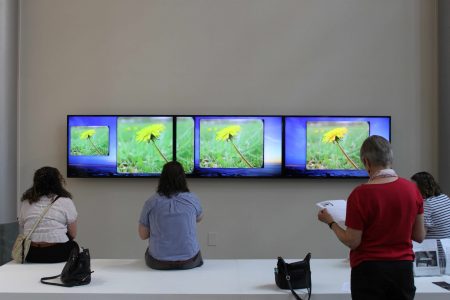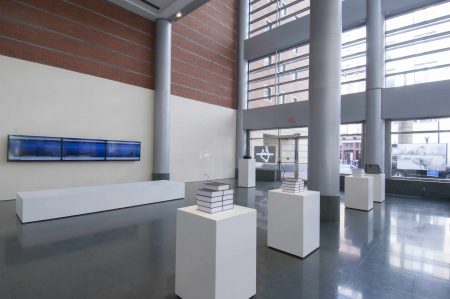Filmmaker and video/conceptual artist C. Jacqueline Wood’s show What Makes a Life at the Weston Art Gallery from May 4 – June 10, 2018 explores how virtual archeology and intermedia modes allot for new narratives of storytelling, proffering from a series of interconnected installations that concern themselves with information networks. The five multi-component installations, on view in the atrium ground floor at The Weston, engage in tangible analog media – at times using projections and photographs as source materials – and juxtapose the mythos of materiality with the ephemera of a signifier-free virtual plane to disperse and disseminate personal/collective histories. By engaging in both the digital and physical archivist mode – a collection of moving digital images are presented alongside a series of printed books that catalogue Wood’s consumption and affinity towards physical media – the artist aligns herself with contemporary new media theorists such as Lev Manovich and Andreas Kratky, who explore the archaeology of new media networks, systems, and affect theory. Wood benefits from a subtle criticism of the cold, mechanistic modes of new media interaction by providing criticism via her idealistic and kindly, humane perspectives. Wood offers poetic modules built on chance operations that subversively criticize their participatory crux.
Wood’s principle relay into conceptual installation is in “What Makes a Life – Volumes 1, 2, 3” (2018), which displays three columns of different hardbound stacked books, separated by volume. This diaristic piece denotes Wood’s ordered, compulsive, and compelling response to chronicling all the media sources that she has received throughout her relationships, friendships, education, and personal accumulation efforts. Although the books are not displayed in their open form – they are closed signifiers, hence reminiscent of artbooks’ furtive conceptual ethos – they do engage in Wood’s arduous process of taking personal inventory. Thus, the clinical towers of books locate themselves within a rather human narrative, as Wood’s revisited favorite texts are mated with newspaper clippings, bits of ephemera, scribbles, notes, DVDs, LPs, and magazines. “The volumes tell my story” Wood offered during her artist-talk on the evening of Wednesday, May 9, while recounting how she and her mother undertook the tabulation of indexing these items. At one point Wood lost half of her catalogue due to an external chance operation – as the archive was not backed up, she was forced to revisit the entire project and start from a halfway point. Aside from a whimsical “making-of” story, this insight navigates the juxtaposed dichotomy that What Makes a Life seeks to implore – the emotional navigation and parsing between new media (Wood’s inherent language as a video artist and filmmaker), analog modes, and their connected trans-informational relay.
The mediation between two disparate but allied planes transpires in familial bounds with Wood’s CRT monitor/single-channel video “Color Transparency” (2018). The source imagery for this piece is a 35mm slide that Wood found amongst her grandfather’s photography collections. Her grandfather, whom Wood describes as an avid naturalist and environmentalist, pictured natural phenomena and landscapes during his travels. The images displayed in Wood’s 3-minute 30-second loop are of two juxtaposed landscapes displayed through double exposure development processes that construct newfound narratives. As the framework of trees, leaves, and foliage remnants dissolve into foreground and background, Wood’s new media processes unravel themselves in turn. Wood scanned her grandfather’s photograph and made an analog recording of the file, which was consequently dubbed over ad nauseum until the resulting image facilitated a multi-generational recording. The final product showcases contrasting and convergent case examinations that mirror the construction of memory – Wood’s novel narrative involves the affect of disappearance, deterioration, and origination.
“Color Transparency” is a redolent reminder of video artist Bill Viola’s “The Reflecting Pool,” which visually describes the stages of transition from day to night, motion to stillness, and time to timelessness by instrumentalizing specific video-editing techniques, technologies, and spatial manipulation. Viola’s end result is that of a psychedelic series of chance-operations that blend thematic time-coding transposition, birthing constructed illustrations of temporal symmetry and duality, as does Wood’s piece. “Color Transparency” uses new media processes to create a degraded image, at ends with the conventional amelioration and restoration techniques traditionally ascribed to contemporary digital processing. German filmmaker, visual artist, and theorist Hito Steyerl notes in her essay “In Defense of the Poor Image” that new media modes allow for a “ghost of an image” vis-a-vis itinerant images distributed for free and squeezed through digital connections. Such degenerate images compress, reproduce and “remixe” channels of distribution. In doing so, such intentionally degraded images denote their collective and individual histories, underscoring the processes involved herewith. “Poor images,” pixilated and bleary, such as those that manifest in Wood’s “Color Transparency” also reveal the conditions of their marginalization, affirming the constellation of social forces that lead to their virtual circulation. The intentionally degraded images may not unite with the archival mode until it is noted that they act as genealogical constructs that exhibit the remnants of new media processes – rampant privatization of intellectual content, along with online marketing and commodification enable appropriation (Steyerel 4). Wood denotes all of these factors of virtual life in What Makes a Life – “Color Transparency,” in particular, invites excavation via manipulated and repeated conditional operations.
“Machines Making Meaning” (2018) features 140 transparent color slides on a slide projector that displays text paired with images sourced from Google Images. During the process of cataloguing the books in “What Makes a Life – Volumes 1, 2, 3,” Wood erased the images’ sources and tried to make sense of the phrases out of context, traversing Google Images to yield results that range from predictable collages to humorous consequences. Pop culture figures, art historical images, and unforeseen residuum inform one another. Wood’s process is evocative of automatic writing – generative poetry has a long history married to the literary use of chance operations by historical avant-garde poets. Randomness and chance reflect different cultural and epistemological contexts, where chance and randomness are context-bound and reflect different artistic agendas (Baillebache 38). Wood’s endeavor, where she selected the first image yielded by the search of a phrase, curiously investigates typing media to language and imagistic representations therewith. “Machines Making Meaning” uses appropriation to reflect a sharing virtual economy built on freely accessible images and information stripped of original context and interpreted through newfound pairings/signifier-chains.
The three-channel video “What Makes a Life (I Look at These Windows More Than I Look at Your Face)” (2018) is presented on three connected monitors. The piece explores the digital world, traversing Google, Youtube, and Giphy to reveal a series of repeated windows displaying moving images, photographs, and Wood’s means of navigating new media architecture. Recorded on a sophisticated and high-resolution screen-capture, Wood’s series of images are paired with an aural selection: James Brown’s “Live at the Apollo, Volume II.” This live musical recording – sexual, improvisational, sweaty, and palpable – juxtaposes the databases that operate along cold and authoritative operational ontologies. By collecting metadata from users or necessitating advertisements, powerhouse search engines such as Youtube and Google subversively lionize capitalism, framed within a contemporaneous internet stripped of Net Neutrality freedoms. Brown’s crooning soul vocals provide a dichotomous pole of carnal and fleshy vigor. One particularly captivating series of moving images shows bare hands that flip through print media, paired with Brown’s chauvinistic cull of “It’s A Man’s World.” While the obvious feminist undertone of Wood’s digital landscape-creation destabilizes Brown’s lyrics, it seems more likely that Wood’s participation in these cold, authoritative virtual passages carries its pastiche from calculated search results that frame the internet’s structured and deliberately designed virtual experience(s).
Wood explores what Lev Manovich terms “digital cinema,” where one can enter virtual three-dimensional spaces to view and interact with flat images that function as simulations of reality and subsequent socio-economic conditions (Manovich et al. 54). Manovich and Andreas Kratky’s collaborative project in “Soft Cinema: Navigating the Database” investigates the aesthetic possibilities of computer-driven cinema, analyzing different production contexts that use digital moving images (the pair make use of Hollywood films, music videos, CD-ROM games, and artworks alike). Wood reviews interface metaphors that suggest a distinct logic of the digital moving image. Consequently, it is only apt that Wood prefaced her Weston artist-lecture by noting that – despite her filmmaker background and career as the sole proprietor at Golden Hour Moving Pictures’ production-house – she seeks more conceptual goals within her personal art-production. By adopting a penchant for interactive virtual architecture in “What Makes a Life (I Look at These Windows More than I Look at Your Face),” Wood’s performatory chance operations locate photographic and filmic conditions within painterly displays of graphic virtual cinema. In the essay “What Is Digital Cinema” Manovich argues that such media-sublimation is what has displaced cinema’s identity as a media art (Manovich et al. 72). Wood’s archeologies of moving pictures usurp the convincing illusion of dynamic reality, superseding “old media” techniques for creating and displaying moving images via a haptic, circulatory space.
When I question her about theorists and artists that inform “What Makes a Life (I Look at These Windows More Than I Look at Your Face),” Wood mentions that she recently read the entirety of Marshal McLuhan’s cannon. McLuhan is perhaps most famous for his essay “The Medium is the Message,” where he forwards that media technologies function as extensions of the central nervous system (and, more broadly understood, human bodies) while embedding a transmitted image within the symbiotic relationship by which the medium influences how messages are perceived. Wood’s role as a disembodied participant in her media amalgamation and virtual landscapes explores human subjectivity within circulatory virtual bounds. What Makes a Life’s poignant compositions and new media collages take part in the very virtual landscapes Wood critiques, locating her work in intermedia and transmodern critical metaphor.
–Ekin Erkan
Works Cited
Baillehache, Jonathan. “Chance Operations and Randomizers in Avant-Garde and Electronic Poetry: Tying Media to Language.” Textual Cultures: Texts, Contexts, Interpretation, vol. 8, no. 1, 2014, pp. 38–56., doi:10.14434/tcv8i1.5049.
Manovich, Lev, and Melentie Pandilovski. Lev Manovich: Soft Cinema. Experimental Art Foundation, 2007.
McLuhan, Marshall. The Medium Is the Message. Gingko Press, 2005.
Steyerl, Hito. “In Defense of the Poor Image.” e-Flux, vol. 10, Nov. 2009, www.e-flux.com/journal/10/61362/in-defense-of-the-poor-image/.






